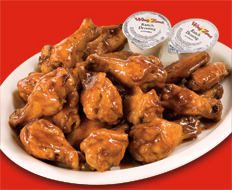The idea for Wing Zone was hatched in a fraternity house in 1991, but the first store didn’t open until two years later. Take-out and delivery wings were the brainstorm of fraternity brothers Matt Friedman and Adam Scott, who, while studying at the University of Florida, wanted to feed themselves and fellow Gators something besides the delivery mainstays of pizza and subs.
“Wings were something you couldn’t get delivered then,” Friedman says. “So we wrote a business plan focused on takeout and delivery. We did the testing out of our fraternity house kitchen, and then in my senior year of college we opened our first restaurant.”
Friedman was a marketing major and Scott majored in finance. For the most part, they have stuck with those roles. “I’m more in sales, marketing, and franchising, and he’s still into the numbers,” Friedman says. “And we actually get along.”
Friedman says when the first Wing Zone opened in Gainesville, he and Scott were “true owner/operators—cooking, delivering, and doing whatever it took.”
Between 1993 and 1999, the two expanded to six additional locations, all company owned. “We went into the closest and biggest college markets within driving distance,” Friedman says.
Wing Zone
CEO: Matt Friedman
Headquarters: Atlanta
Year started: 1993
Annual sales: $40 million
Total Units: 83
Franchise Units: 81
After witnessing the concept’s initial success, friends, store managers, and even customers started asking how they could get involved with Wing Zone. So the founders decided their best opportunity for future growth was through franchising. Wing Zone began franchising in 2000 and has since grown to 83 units. Future growth plans include international locations and the opening of 12–15 new domestic stores in 2011 and 15–20 in 2012. In addition, there will be a Wing Zone outlet on 12–14 military bases by the end of 2012.
Of the new traditional stores, 50 percent will be located in existing Wing Zone markets, with the remaining going in new markets like Chicago, Seattle, and California.
Friedman says folks at Wing Zone “are fans of flavor. We don’t just have mild, medium, and hot. We were the first to come out with a variety of flavors.”
That’s flavors, not sauces. “Sauces are boring,” Friedman says. “Flavors are exciting.”
The flavors at Wing Zone range from what the company refers to as “wet flavors” like Buffalo and BBQ, to its newly developed “dry flavors.”
“We have introduced flavors, or rubs, which are dry seasonings applied to wings,” Friedman says. “After the nonbreaded wings are cooked, they are tossed in the dry rub so it adheres.”
Dry flavors include Sea Salt and Vinegar, Cool Ranch, and Blackened Voodoo, a Cajun flavor profile. All flavors have a heat index of 0–4, and many are being renamed with the help of Wing Zone customers.
“We’re having fun with it by asking for help on Facebook and Twitter,” Friedman says. “We just want to make the flavor names more enticing, so instead of hot we’ll have Hot Shot, and medium buffalo will be Buffalo Blitz.”
Wings make up 50–60 percent of the menu mix at Wing Zone, which also offers salads, fried shrimp, chicken tenders, half-pound burgers, chicken sandwiches, and side items like Wedge Fries, Cheese Fries, Onion Rings, Mozzarella Stix, Fried Mushrooms, and Fried Pickles.
About two thirds of the wings sold at Wing Zone are original style and a third are boneless, but the boneless are gaining in popularity, Friedman says.
“Boneless wings are a great addition to our menu,” he says. “They give people a different look at the product. They are less messy, so they are good for lunches and parties. And some people just don’t like meat on the bone and prefer these because they are made with full white-meat chicken breast chunks.”
Friedman says the ticket average at Wing Zone is fairly high at about $17 because customers are often ordering for multiple people.
Wing Zone stores are typically about 1,200 square feet. The compact size means lower costs for occupancy, utilities, and build out. About 70 percent of a Wing Zone footprint is kitchen, with the remainder being counter area, lobby, tables, and restrooms.
“A lot of our stores have fewer than 20 seats because we are not a dine-in restaurant,” Friedman says. “Ninety percent of our food is taken out of the store and of that, delivery represents 40–50 percent of our revenue.”
He says the tables at a Wing Zone are more for waiting than for dining. “We cook to order, and the average wait time is 10–12 minutes,” Friedman says. “So most people call ahead.”
The chain also launched three freestanding locations with drive thrus. “I don’t know of any other regional or national chain with a drive thru for wings,” Friedman says. “We had to make a slight change to the way we cook our product to make it work in these locations.”
At the drive-thru locations, wings are par cooked and then held until ordered, when the cooking process is completed and the flavors applied.
“The wings are still customized to the customer’s liking right out of the fryer,” Friedman says.
Friedman says the majority of Wing Zone locations will continue to be inline models, because the drive-thru stores require a higher investment. Still, he says it’s good to have other options, and toward that end, a third option is being tested. The Wing Zone Grill and Tap, which offers table service and serves beer and wine, is being tested in Austin and San Antonio, Texas.










